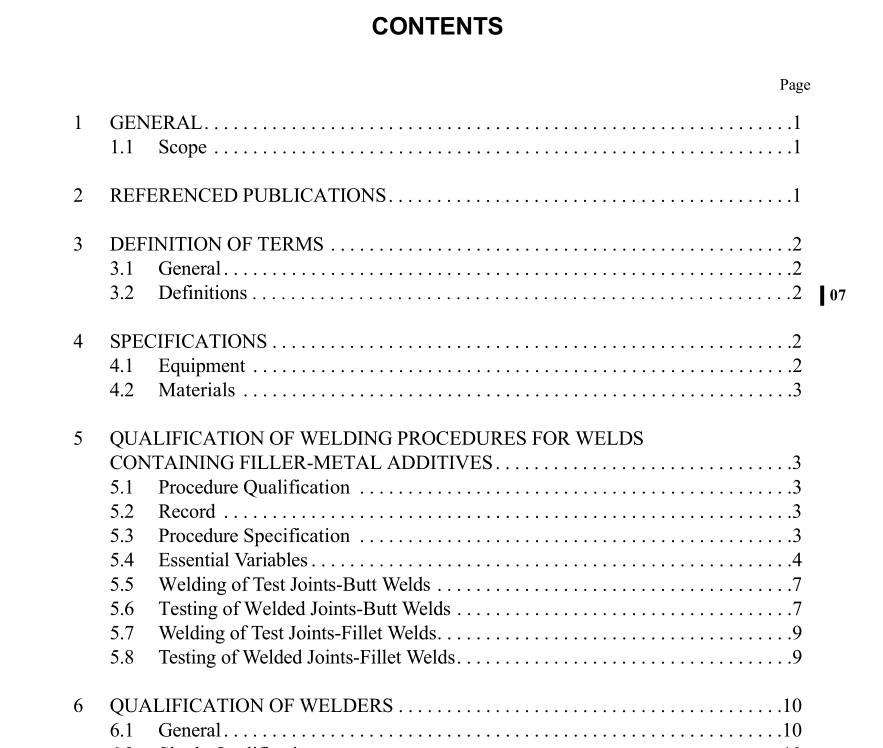API STD 1104 pdf download

API STD 1104 pdf download.Welding of Pipelines and Related Facilities
1 General
1.1 SCOPE
This standard covers the gas and arc welding of butt, fillet, and socket welds in carbon and low-alloy steel piping used in the compression, pumping, and transmission of crude petro- leum, petroleum products, fuel gases, carbon dioxide, nitro- gen and, where applicable, covers welding on distribution systems. It applies to both new construction and in-service welding. The welding may be done by a shielded metal-arc welding, submerged arc welding, gas tungsten-arc welding, gas metal-arc welding, flux-cored arc welding, plasma arc welding, oxyacetylene welding, or flash butt welding process or by a combination of these processes using a manual, semi- automatic, mechanized, or automatic welding technique or a combination of these techniques. The welds may be produced by position or roll welding or by a combination of position and roll welding. This standard also covers the procedures for radiographic, magnetic particle, liquid penetrant, and ultrasonic testing, as well as the acceptance standards to be applied to production welds tested to destruction or inspected by radiographic, magnetic particle, liquid penetrant, ultrasonic, and visual test- ing methods. The values stated in either inch-pound units or SI units are to be regarded separately as standard. Each system is to be used independently of the other, without combining values in any way. Processes other than those described above will be consid- ered for inclusion in this standard. Persons who wish to have other processes included shall submit, as a minimum, the fol- lowing information for the committee’s consideration: a. A description of the welding process. b. A proposal on the essential variables. c. A welding procedure specification. d. Weld inspection methods. e. Types of weld imperfections and their proposed accep- tance limits. f. Repair procedures. It is intended that all work performed in accordance with this standard shall meet or exceed the requirements of this standard.
3 Definition of Terms
3.1 GENERAL The welding terms used in this standard are as defined in AWS A3.0, with the additions and modifications given in 3.2. 3.2 DEFINITIONS 3.2.1 automatic welding: Arc welding with equipment that performs the entire welding operation without manual manipulation of the arc or electrode other than guiding or tracking and without a manual welding-skill requirement of the operator. 3.2.2 branch weld: The completed groove and/or fillet weld joining a set on or set in branch pipe or a set on or set in branch fitting to a run pipe. 3.2.3 company: The owner company or the engineering agency in charge of construction. The company may act through an inspector or another authorized representative. 3.2.4 contractor: Includes the primary contractor and any subcontractors engaged in work covered by this standard. 3.2.5 defect: An imperfection of sufficient magnitude to warrant rejection based on the stipulations in this standard. 3.2.6 imperfection: A discontinuity or irregularity that is detectable by methods outlined in this standard. 3.2.7 indication: Evidence obtained by nondestructive testing. 3.2.8 internal concavity: A bead that is properly fused to and completely penetrates the pipe wall thickness along both sides of the bevel, but whose center is somewhat below the inside surface of the pipe wall. The magnitude of concav- ity is the perpendicular distance between an axial extension of the pipe wall surface and the lowest point on the weld bead surface. 3.2.9 mechanized welding: A process where parame- ters and torch guidance are controlled mechanically or elec- tronically but may be manually varied during welding to maintain the specified welding conditions. 3.2.10 position welding: Welding in which the pipe or assembly is not rotating while the weld is being deposited. 3.2.11 qualified welder: A welder who has demon- strated the ability to produce welds that meet the require- ments of Sections 5 or 6. 3.2.12 qualified welding procedure: A tested and proven detailed method by which sound welds with suitable mechanical properties can be produced. 3.2.13 radiographer: A person who performs radio- graphic operations. 3.2.14 repair: Any rework on a completed weld that requires welding to correct a fault in the weld that has been discovered by visual or nondestructive testing and is beyond this standard’s limits of acceptability.









